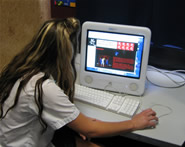Pre-planning

When planning the Year 11 course, Steve knew he had highly motivated, high-achieving students, and it was therefore vital to maintain their enthusiasm and learning momentum. The course was planned to deepen the breadth of knowledge students had gained in the four Year 10 units and prepare them for ICT courses at Level 2 and Level 3, and at the same time achieve a balance between learning technological practice and ICT domain knowledge and skills.
Specifically, Steve wanted the students to move beyond web-authoring software, such as Dreamweaver , which has a 'what-you-see-is-what-you-get' (wysiwyg) interface, and write some code themselves into a text editor using XHTML and Cascading Style Sheets (CSS); and experiment with Flash and ActionScript. Rather than focus on one of the components of practice each term as they had done the previous year, students would be required to integrate the three components into a single, large project.
The Year 11 course was designed to dovetail into a planned Year 10-Year 13 learning progression, Malcolm says. "Year 10 is like the sampler if you like – lots of skills but nothing in too much depth. Year 11 is much deeper, but it's still a teacher-directed project – students are all doing something related to the web. They are all learning the same set of skills to start with, and they don't have a choice on the issue. The issue is described, and students simply choose a context for that issue. Year 12 is far more open in terms of how they choose their issue and what sort of outcome they produce. And at Year 13 students select a client and identify a suitable client issue and from that they choose their own set of skills, which could be quite different from their classmate's."
The Year 11 course would cover: website creation, computer graphics, animation and programming, presentation and design skills, and the social issues related to ICT. Steve spent a lot time before the start of the 2007 school year developing resources, including handouts and a series of worksheets; he estimates about two-thirds of the resource material was printed out as hardcopy. He also used some of the Natcoll publications, including Natcoll Flash and Natcoll ActionScript.
Steve arranged a software developer from Tauranga software company Cucumber Software to visit the class. Before the visit, Steve sent the guest speaker a brief (.pdf, 54Kb), outlining where the students were at and suggesting some areas that could be covered in the presentation.
